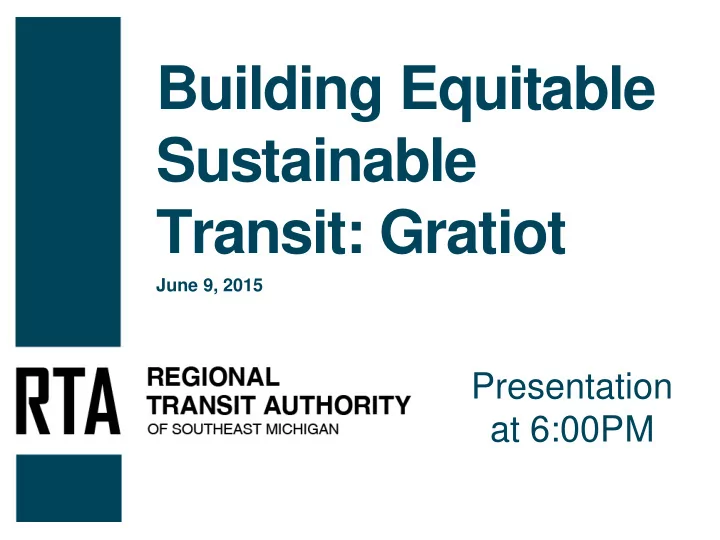

Building Equitable Sustainable Transit: Gratiot June 9, 2015 Presentation at 6:00PM
Topics for Presentation • Transit Lingo • What is the Regional Transit Authority • Other Transit Projects • Gratiot Avenue “At a Glance” • Different types of Transit options • What do you want to see on Gratiot? • What will the outcome be? • What is the process? When will this happen? • Having your voice heard and staying involved
Transit Lingo Term Definition BEST Building Equitable Sustainable Transit RTA Regional Transit Authority of Southeast Michigan FTA Federal Transit Administration Mode Various types of transit, such as bus, light rail, subway BRT Bus Rapid Transit, a type of mode Locally Preferred Alternative, describes the mode, location LPA and station locations Transit Oriented Development, an area near a transit TOD station to increase mixed use density to increase ridership National Environmental Policy Act, requires documentation NEPA to determine impacts that a project has on the environment
What is the Regional Transit Authority? Cooperating Partner/Related Agency
Where else are there RTA’s? Dayton RTA Chicago RTA Greater Cleveland RTA Des Moines RTA New Orleans RTA
Current RTA Projects
Regional Transit Master Plan • Overall transit vision for Southeast Michigan • Coordination with current transit providers • Includes bus, paratransit, express bus, rapid transit and rail • Considers BEST plans for Michigan, Gratiot and Woodward • Draft Plan in November 2015
Woodward Avenue • Initial planning is complete and Bus Rapid Transit has been endorsed by the communities along the Corridor • Transit would generally run along center of Woodward Avenue • Preliminary station locations identified • Environmental Review has begun • Report in November 2015
Michigan Avenue • • Evaluates transit alternatives Focuses on complete streets between Detroit and Ann and economic development Arbor, including connections • Explores new rapid transit to to Metro Airport complement existing and • Considers end-to-end travel planned service needs, as well as links • LPA Report in March 2016 between the corridor communities
Gratiot Avenue • Examines enhanced transit between Downtown Detroit and M-59 • Includes communities of Detroit, Eastpointe, Roseville, Clinton Township and Mount Clemens • Recommends the type of transit, where it runs and best locations for stations • LPA Report in March 2016
Gratiot “At a Glance” Previous Studies along the Corridor: • 2001: Improving Transit in SE Michigan • 2008: Regional Transit Service Plan • 2008: Gratiot Avenue Corridor Improvement Plan • 2009: Detroit Transit Options for Growth Study • 2014: Gratiot Avenue Pilot Corridor
Gratiot “At a Glance” • 23 miles between M-59 and Detroit • 45 – 50 minutes to drive along Gratiot 40 – 50 minutes to drive along I-94 • 55 – 65 minutes to ride on SMART • • 12,000 people ride on DDOT/ SMART • 115,400 households within one- mile • Destinations include: • Downtowns, Eastern Market, Ford Field/Comerica Park, Libraries, Medical Centers, Shopping, Education, Employment and more…
Different Types of Transit Express Bus • Route can be flexible and move • Typically commuter service only • Express Bus Mixed in with traffic or bus only lanes • Does not have enhanced stations or on-board amenities • Detroit, New York, and LA • ~ $1 million per mile • Stops every 1 mile or more
Different Types of Transit Streetcar • Fixed guideway • Can be mixed in traffic or separated • Typically for short routes • Enhanced stations and on- board amenities • New Orleans, Philadelphia, Detroit • ~ $50 million per mile • Stations every ¼ to ½ mile
Different Types of Transit Bus Rapid Transit • Separated guideway or mixed in traffic • Flexibility in routing • Travel time advantage if separated • Enhanced stations and on- board amenities • Cleveland, Chicago and Grand Rapids • ~$17 million per mile • Stations every ¼ mile to 1 mile
Different Types of Transit Light Rail Transit • Separated guideway • Travel time advantage • Enhanced stations and on-board amenities • Attractive to choice riders • Minneapolis, San Jose • ~ $63 million per mile • Stations every 1 mile
Comparison of Modes Express Bus Streetcar Bus Rapid Transit Light Rail 40’ or 60’ bus 40’ or 60’ bus Types of Vehicles 1-2 car trains 2-3 car trains Station Frequency 1 mile to 5 miles ¼ mile to ½ mile ¼ mile to 1 mile 1 mile 10 – 30 miles 1 – 5 miles 5 – 30 miles 20 – 50 miles Route Length Mixed with Traffic Yes Possible Possible No Level Boarding No Yes Yes Yes Route can be flexible Yes No Yes No Average Cost to build $1M $50M $17M $63M per mile
Benefits of Rapid Transit • Better for business – access to jobs is better • Reduces congestion • Improves public health • Improves the environment • Increases in number of businesses • Increase in property values
What do you want to see? • A service that is reliable • Service that is provided all throughout the day • Frequent service throughout the day and weekends • Service that can increase development along the corridor • Service that is competitive with the automobile *Based on outreach done to date
What will the outcome be? • Location of the transit within the roadway (cross-section) • Center-running versus side-running • Mixed in with traffic or separated from traffic
What is the process?
How to have your voice heard and stay involved • Give us your email • Twitter • @RTAMichigan • #HeyRTA • Facebook • MySidewalk.org • www.rtamichigan.org Next Public Meeting in September or October 2015
Questions?
Recommend
More recommend